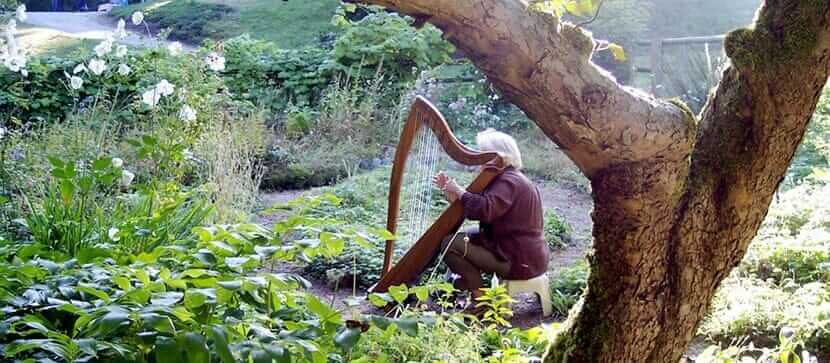“Gardening is an active participation in the deepest mysteries of the universe.” —Thomas Berry
Mara Grey—botanist, Celtic harpist, storyteller, master gardener, and author of The Lazy Gardener and The Complete Idiot’s Guide to Flower Gardening—volunteers as caretaker for the Appletree Garden at Chinook.
When I spoke with Mara in the shade of the old apple tree, our conversation ranged from Chinook history and garden stewardship to ancient languages and the power of story. We spoke of the early garden stewards, like Marybeth Crandall and Wilma O’Nan, and the underlying geometry of the garden paths—three interlocking circles, in the tradition of a knot garden.
“In this garden,” Mara said, “I feel a sense of interconnectedness with the rest of the land. Gardens are like microcosms of dealing with nature.” Discussing what makes gardening “work” or “play,” Mara said she feels the work she does here contributes to the whole organization. “I have a feeling that by bringing the plants here, I’m feeding people. In that way, I do feel a sense of contributing to the work of the Institute. Being here is never work—it’s just plain fun.”
Mara’s connection with nature—both here, under the apple trees, and in other gardens where she works, lives, and volunteers—is enhanced by her musicianship and intercultural experiences. “There are different ways of talking to nature,” she said. “I fell into a certain relationship with nature because I started playing my harp outside. I realized, ‘they like this!’ Music is a language, in a sense.”
Mara’s affinity for heritage cultures took root in her youth, growing up in Hawai’i before it was a state. “When you grow up in a place like that, you know that there’s this other reality around you . . . what I got was a sense of a culture that was present, but which wasn’t mine. I needed something that was, which was why I went to the Celtic.”
In addition to playing Celtic harp, Mara has studied Scottish Gaelic for many years. “There’s a storyteller and weaver named Norman Kennedy,” she told me. “I had a workshop from him once. He said that he has the talent of being able to learn a song or story after just one hearing. He went from the East to the West coasts of Scotland. When these old people found out he could do that, they began to put stories into him, one after another. This was a dying culture. These stories were gone if someone didn’t learn them. He does a lot of passing them on—the weaving, and the songs, and the stories.”
“Learning Gaelic, I’ve found out how different it is to look at the world in a different language,” Mara said. “Instead of saying ‘I’m hungry,’ or ‘I’m sad,’ you say, “there is hunger on me. There is sadness on me. You aren’t IT. You can take it off. And in the Gaelic-speaking communities, reality is pretty flexible. Everybody knows there’s second sight—it’s part of everyday life.”
Mara first came to Chinook through having read a book about Findhorn, and said the garden is a place to encounter things which fall outside the scientific paradigm. “I’m an extremely skeptical person, so the idea of co-creating with nature was strange. It’s taken me 30 years to come to terms with uniting the viewpoints of science and things outside it.” Mara added that she’s also been influenced by a Native American elder, for whom she’s provided transportation to ceremonies for about fifteen or twenty years. “Their traditions have such a long history—they’re grounded in a lot of experience.” Today, Mara sees the magic of the inexplicable through the eyes of her granddaughter, a sometimes visitor to the Appletree Garden.
At the close of our conversation, Mara explained her goals for the garden—one, to build a library of flower essences, with as many kinds of plants in the Appletree Garden as possible. “Each plant gives something to the people that come here,” she said.”I have wild tulip bulbs from the mountains of Afghanistan and Northern Iran—plants from New Zealand, South Africa, Japan, and China. The garden is like the center of a web of relationship, not only with all the people who have worked there over the years abut also with the places that the plants come from.”
Second, Mara said she hopes to leave the garden better than she found it. “When I hand this garden over to someone else, I want it to be as easy care as possible,” she said. “Sometimes that means digging out a bed full of perennial weeds, like quackgrass. It takes time to create a bed you can leave on its own.”
“I fall in love with plants,” Mara said, “Those purple-blue ones . . . wildflowers, Brodeia. I sowed them in the 1980s. I love them.” She went on to say that she doesn’t actually consider herself a great gardener, despite three decades of experience and an extensive resume. “I like wild places more than I like gardens—I like being with plants. But I try experiments, like, ‘if I don’t water this, will it die?’ I’ve learned a lot! It’s play.”
Would you like to make a simple gift to the Appletree Garden?
Mara and her son Ryan, another dedicated volunteer, request donations of rounded stones! Leave any smooth stone, grapefruit-sized or larger, by the garden gate. They’ll be used to edge the garden pathways. Mara also welcomes email inquiries if you have a plant in your garden which you’d like to offer for the “plant library,” or if you’d like to help work in the Appletree garden.

